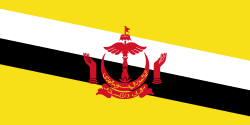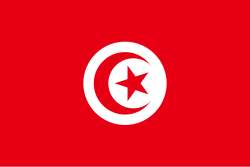- one of the Five Pillars of Islam
- Flag of Afghanistan (Taliban)
- bears the Shahada , [1]
- The secondary flag used by the Syrian transitional government bears the Shahada : "There is no god but Allah. Mohamed is the messenger of Allah" in Arabic
- Flag of Afghanistan (tricolor)
- the emblem bears the Shahada and the Takbir [2]
- Flag of Algeria
- bears a star and crescent and the green represents Islam [3]
- Flag of Azerbaijan
- the red band bears a star and crescent and the green represents Islam [4]
- Flag of Bahrain
- has five points that represent the Five Pillars of Islam [5]
- Flag of Brunei
- bears a crescent [6]
- Flag of Comoros
- bears a star and crescent and the green represents Islam [7]
- Flag of Iran
- the center emblem is a stylized form of the Arabic word Allah and its five parts represent the Five Pillars of Islam; the red and green bands bear the Takbir [8]
- Flag of Iraq
- the white band bears the Takbir [9]
- Flag of Jordan
- bears a seven-pointed star that represents the seven verses of the Quran's first chapter [10]
- Flag of Libya
- the black band bears a star and crescent [11]
- Flag of Malaysia
- bears a star and crescent [12]
- Flag of Maldives
- bears a crescent [13]
- Flag of Mauritania
- bears a star and crescent and the green represents Islam [14]
- Flag of Morocco
- the green represents Islam and the pentagram's five points represent the Five Pillars of Islam [15]
- Flag of Pakistan
- bears a star and crescent and the green represents the Muslim majority [17]
- Flag of Saudi Arabia
- bears the Shahada and the green represents Islam [18]
- Flag of Singapore
- the Malay minority added a crescent moon to represent Islam. [21]
- Flag of Somaliland
- bears the Shahada and the green represents Islam [22]
- Flag of Tunisia
- bears a star and crescent and the red represents Islam [24]
- Flag of Turkey
- bears a star and crescent [25]
List of subnational flags
- Flag of Kedah, Malaysia
- bears a crescent [30]



































